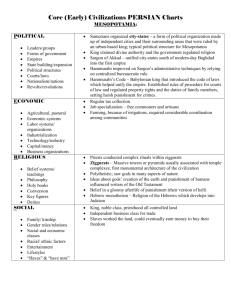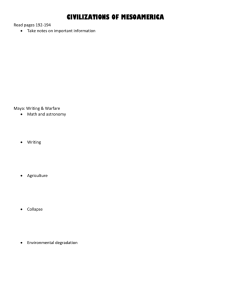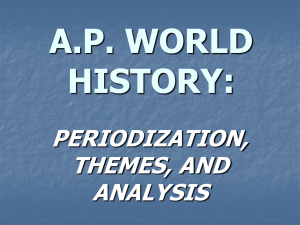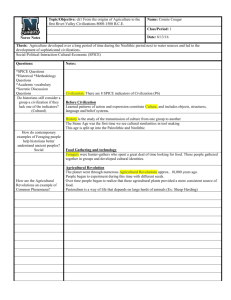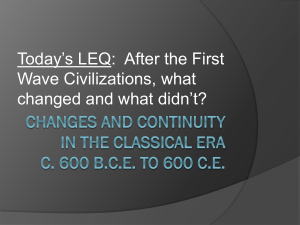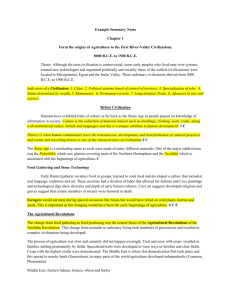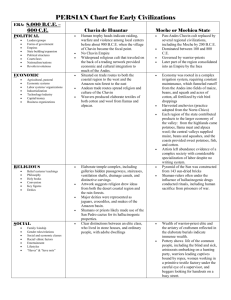Early Civilizations PERSIAN Charts MESOPOTAMIA: POLITICAL
advertisement
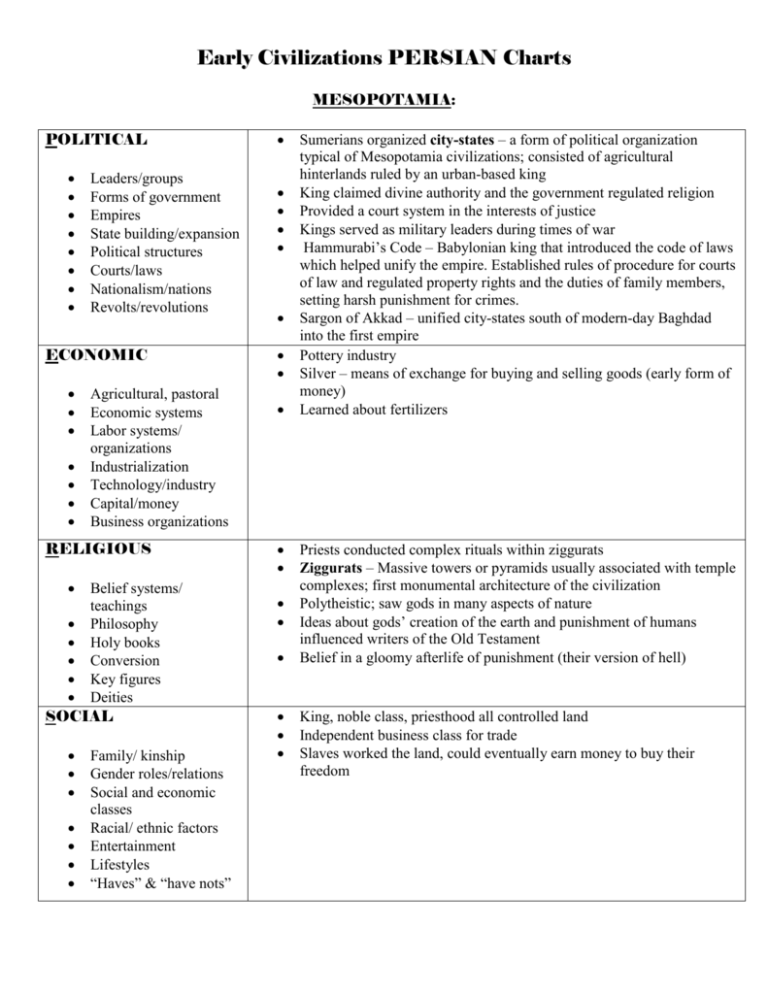
Early Civilizations PERSIAN Charts MESOPOTAMIA: POLITICAL Leaders/groups Forms of government Empires State building/expansion Political structures Courts/laws Nationalism/nations Revolts/revolutions ECONOMIC Agricultural, pastoral Economic systems Labor systems/ organizations Industrialization Technology/industry Capital/money Business organizations RELIGIOUS Belief systems/ teachings Philosophy Holy books Conversion Key figures Deities SOCIAL Family/ kinship Gender roles/relations Social and economic classes Racial/ ethnic factors Entertainment Lifestyles “Haves” & “have nots” Sumerians organized city-states – a form of political organization typical of Mesopotamia civilizations; consisted of agricultural hinterlands ruled by an urban-based king King claimed divine authority and the government regulated religion Provided a court system in the interests of justice Kings served as military leaders during times of war Hammurabi’s Code – Babylonian king that introduced the code of laws which helped unify the empire. Established rules of procedure for courts of law and regulated property rights and the duties of family members, setting harsh punishment for crimes. Sargon of Akkad – unified city-states south of modern-day Baghdad into the first empire Pottery industry Silver – means of exchange for buying and selling goods (early form of money) Learned about fertilizers Priests conducted complex rituals within ziggurats Ziggurats – Massive towers or pyramids usually associated with temple complexes; first monumental architecture of the civilization Polytheistic; saw gods in many aspects of nature Ideas about gods’ creation of the earth and punishment of humans influenced writers of the Old Testament Belief in a gloomy afterlife of punishment (their version of hell) King, noble class, priesthood all controlled land Independent business class for trade Slaves worked the land, could eventually earn money to buy their freedom INTERACTIONS War/conflict Diplomacy/treaties Alliances Exchanges between individuals, groups, & empires/nations Trade/commerce Globalization ARTS Art Music Writing/literature Philosophy Math Science Education Architecture Technology Innovations Transportation ENVIRONMENTAL Location Physical Human/environment Migration/movement Region Demography Neighborhood Urbanization Settlement patterns Disease Cities (2 major ones) One of the few cases of a civilization developing from scratch (with no example to copy from) Farming, because of irrigations, required considerable coordination among communities Trained army; warfare vital to ensure supplies of slaves taken as prisoners Region hard to defend – Sumerians fell to the Akkadians, who later fell to the Babylonians (who extended the empire). Invasions of Semitic people from the south introduced language and began to dominate the region, they adopted the culture so key features of civilization persisted, but large political units declined in favor of small city-states or regional kingdoms. Eventually invasions by Assyrians and Persians created large empires. Invented wheel for transportation Cuneiform – writing developed by the Sumerians using wedge-shaped stylus (like a ballpoint pen) and clay tablets. Statues and painted frescoes decorated temples of the gods Astronomy – helped with development of the calendar Mathematics – system on numbers based on units of 10, 60, 360 that we still use to calculate circles and hours Founded in the valley of the Tigris and Euphrates Rivers called Mesopotamia (the land between the rivers); irregular flooding Sumerians – people who migrated into Mesopotamia about 4000 B.C.E.; created first civilization within region; organized area into city-states More vulnerable to invasions due to a lack of natural barriers Located in modern-day Iraq Territory found in the fertile crescent, an area between the Persian Gulf and the Mediterranean Sea in southwest Asia Sumer, Babylon -2- Early Civilizations PERSIAN Charts EGYPT: POLITICAL Leaders/groups Forms of government Empires State building/expansion Political structures Courts/laws Nationalism/nations Revolts/revolutions ECONOMIC Agricultural, pastoral Economic systems Labor systems/ organizations Industrialization Technology/industry Capital/money Business organizations RELIGIOUS The king, or pharaoh possessed immense power – godlike; “caused the sun to rise, the Nile to flood, and the crops to grow” Complexity of coordinating irrigation along the Nile suggests more government control 3 dynasties over 3 kingdoms (Old, Middle, and New) with intermediate periods An elaborate bureaucracy with organized labor and public works Vizier – chief minister in charge of the running of the government Upper and Lower Egypt were later united into one empire around 3,100 B.C.E. by King Menes Traded Government directed the agricultural economy State controlled taxation, prices, and the distribution of goods Polytheistic Belief in the afterlife based on deeds while alive King, nobles, priests, scribes/merchants/artisans, peasants, slaves Women could do business and own/trade property, seek divorce, manage estates Belief systems/ teachings Philosophy Holy books Conversion Key figures Deities SOCIAL Family/ kinship Gender roles/relations Social and economic classes Racial/ ethnic factors Entertainment Lifestyles “Haves” & “have nots” INTERACTIONS War/conflict Diplomacy/treaties Alliances Exchanges between individuals, groups, & empires/nations Trade/commerce Globalization ARTS Art Music Writing/literature Philosophy Math Science Education Architecture Technology Innovations Transportation ENVIRONMENTAL Location Physical Human/environment Migration/movement Region Demography Neighborhood Urbanization Settlement patterns Disease Cities (2 major ones) Trade & technological influence from Mesopotamia Egyptian influence spread up the Nile into present-day Sudan to impact later African civilizations The kingdom of Kush interacted with and invaded Egypt. Evidence suggests extended military power over Palestine in the east, Libya in the west and Nubia in the south. Pyramids for pharaohs tombs Mathematics was advanced – idea of a day divided into 24 hours Art was cheerful and colorful pictures decorated on tombs Hieroglyphics – formal writing system based on pictorial images with ideas or sounds; (royal/funeral/ divine inscriptions) Demotic – everyday writings; daily documents, accounting, literary texts, letters, manuals, poems Higher literacy rate than the Mesopotamians Medicine – check pulse, set broken bones, looked for symptoms, treated wounds/fevers, and did some surgical procedures Located in northern Africa Along the Nile River by 3000 B.C.E. Irrigation to support agricultural economy Surrounded by deserts, mountains, seas, cataracts [rapids], which served as natural barriers for defense. Canals and dikes, to regulate the natural flow of the Nile; predictable flooding Population of 350,000 by 4000 B.C.E. to nearly 5 million by 1,500 B.C.E. Absence of large-scale cities like Mesopotamia had Memphis – city for ruling family and bureaucrats of the Old Kingdom Thebes – one of many extensive settlements across many metropolitan areas -4- Early Civilizations PERSIAN Charts INDUS RIVER VALLEY: POLITICAL Leaders/groups Forms of government Empires State building/expansion Political structures Courts/laws Nationalism/nations Revolts/revolutions ECONOMIC Agricultural, pastoral Economic systems Labor systems/ organizations Industrialization Technology/industry Capital/money Business organizations RELIGIOUS Family/ kinship Gender roles/relations Social and economic classes Racial/ ethnic factors Entertainment Lifestyles “Haves” & “have nots” Effective central government due to evidence of organized communities and supervision on daily tasks of large number of laborers Strong ruling class – evidence from the well fortified citadels Powerful priestly class which ruled from the citadels High degree of uniformity suggests a centralized and structured state Extensive trade with cities being major trade centers Grain storage for regulation of grain production and sales Cultivation of wheat, rye, peas, and possibly rice, and cotton Used a standardized system of weights and measure and seals to stamp commodities to facilitate trade Polytheistic Mother goddesses appear to have been objects of worship for common people (fertility = agriculture) Priesthood, upper class Elites less boastful about their position (no elaborate tombs and palaces) Large, richly built houses of 2-3 stories, with indoor plumbing, luxurious bathrooms, brick toilets, and access to running water Belief systems/ teachings Philosophy Holy books Conversion Key figures Deities SOCIAL INTERACTIONS War/conflict Diplomacy/treaties Alliances Exchanges between individuals, groups, & empires/nations Trade/commerce Globalization ARTS Art Music Writing/literature Philosophy Math Science Education Architecture Technology Innovations Transportation ENVIRONMENTAL Location Physical Human/environment Migration/movement Region Demography Neighborhood Urbanization Settlement patterns Disease Cities (2 major ones) Similarities in religion between Indus and Mesopotamia due to trading contacts Also traded with China and Burma Weak military to defend from invaders Invasions from Aryans, an Indo-European group who combined their religious and political ideas with those of the Indus people Well-planned citadels – fortress protecting the city Public bathing Sewer system Streets, organized and laid out on a grid system Complex writing system, which has not been deciphered Located in modern-day Pakistan and parts of India Emerged along the Indus River by 2500 B.C.E. Irrigation systems to catch and control waters from the monsoons and rivers Earthquakes, desertification, monsoons [seasonal winds] may have contributed to downfall Harappa – Major urban complex of the Harappan civilization; laid out on planned grid pattern Mohenjo Daro – Major urban complex of the Harappan Civilization; laid out on planned grid pattern -6- Early Civilizations PERSIAN Charts SHANG CHINA: POLITICAL Leaders/groups Forms of government Empires State building/expansion Political structures Courts/laws Nationalism/nations Revolts/revolutions ECONOMIC Agricultural, pastoral Economic systems Labor systems/ organizations Industrialization Technology/industry Capital/money Business organizations RELIGIOUS Belief systems/ teachings Philosophy Holy books Conversion Key figures Deities SOCIAL Family/ kinship Gender roles/relations Social and economic classes Racial/ ethnic factors Shang established kingdom that would lay the foundations of Chinese civilization with a centralized government needing to rule feuding villagers Hereditary rulers or dynasties with power based on the ancestors and gods Ruled by strong kings – seen as an intermediary between the supreme being and ordinary mortals (Shangdi; Shang = leader; di = high god of the rain cycles) Rulers directed the affairs of the state and bore ritual responsibilities for the fertility of their kingdom and the wellbeing of their subjects Sizeable bureaucracy Peasant and artisan population governed by vassals who served the lords or kings bound to them by personal ties; introduced the system of feudalism Not well-defined by fixed and clearly established boundaries Shang collected tributes from agricultural areas; from the elites they got warriors, laborers, horses, and cattle; from the allies, they got food, soldiers, workers and help with state projects in return for protection; commoners sent tributes to elites, who held land as fiefs from the king (made payments with surplus crops) Mining required large labor force Shang kings controlled access to copper and tin and the production of bronze (limited access to potential enemies) Commoners made labor payments or corvee; workers to royal workshops with bronze; others labored to clear and drain fields, build palaces, excavate tombs, or construct walls to protect towns Polytheistic Special ceremonies were performed Priests served as oracles – sacred people who foretold the future through interpretations of animal bones cracked by heat Reliance on shamans (priests) strongly influenced beliefs and behavior in Shang Era Kings, lords, vassals, peasants No independent priesthood to challenge power Patriarchal society Lords were recruited from ruling families and aristocratic classes Vassals depended on the produce and labor of commoners In return for grants of control over peasants, warrior aristocrats collected tribute which went to the monarch and his court Entertainment Lifestyles “Haves” & “have nots” INTERACTIONS War/conflict Diplomacy/treaties Alliances Exchanges between individuals, groups, & empires/nations Trade/commerce Globalization ARTS Art Music Writing/literature Philosophy Math Science Education Architecture Technology Innovations Transportation ENVIRONMENTAL Location Physical Human/environment Migration/movement Region Demography Neighborhood Urbanization Settlement patterns Disease Cities (2 major ones) Vassals supplied soldiers for kings army and kept peace among the peasants Did not construct monumental architecture; lived in simple houses built of mud and wood Developed in considerable isolation but had some land trade contacts with India and the Middle East Copied chariots the Shang encountered along with horsed imported from central Asia Temporary decline in civilization when invasion disrupted Shang society Less of a break between river valley society and full development of classical civilization than other early civilizations Pottery making Silk-making Writing developed from scratches on bones to ideographic symbols (pictographic characters grouped together to create new concepts) writing came from oracle bones Writing became the key to Chinese identity Art- delicate designs with jade, stone, and ivory Astronomy – developed a calendar Metallurgy and copper casting technology for weaponry, ritual objects, drinking vessels, etc… Located in East Asia Along the Yellow River or the Huang He River in the north and the Yangzi River in the south Irrigation Fertile land, but prone to flooding Annual floods and extensive flood plains were suitable for agriculture and the support of large populations Capital moved as the frontier expanded and contracted; moved 6x before ending up in Anyang -8- Early Civilizations PERSIAN Charts OLMECS: POLITICAL Leaders/groups Forms of government Empires State building/expansion Political structures Courts/laws Nationalism/nations Revolts/revolutions ECONOMIC Agricultural, pastoral Economic systems Labor systems/ organizations Industrialization Technology/industry Capital/money Business organizations RELIGIOUS Belief systems/ teachings Philosophy Holy books Conversion Key figures Deities SOCIAL Family/ kinship Gender roles/relations Social and economic classes Racial/ ethnic factors Entertainment Lifestyles “Haves” & “have nots” Loose confederation of villages, scattered from the coast to the highlands and in large part nestled in river valleys and along the shores of swampy lakes Villages = decentralized but had hundreds, possibly thousands of households apiece Priestly class who made sure villagers adhered to highly ritualized practices Those at the top of the hierarchy of chieftainships commanded villages scattered over larger areas; the larger the domain, the greater the ability to ship the produce of workshops and fields to the chief’s centers or priests’ capitals. Many centuries of advancing agriculture based on the early cultivation of corn and the use of turkeys, dogs, and guinea pigs Villages traded with each other People paid taxes to rulers Olmec = “Inhabitants in the land of rubber” – one of their main exports Subsistence farmers who cultivated most of the foodstuffs needed by their villages, such as maize, beans, squash, and cacao, while shipping lightweight products such as ceramics and precious goods (jade, obsidian, or quetzal feathers) to other villages Religious statues and icons blended human and animal subjects (snakes, jaguars, and crocodiles) Worshipped the same gods Precious goods (jade, obsidian, or quetzal feathers) used to create masks and ritual figurines for religious purposes Devotional activities in all centers/cities Shamans – humans who were believed to have special power to commune with the supernatural and the ability to transform themselves wholly or partly into beasts, such as the were-jaguar ( a being that was part man, part animal) Ceremonial life revolved around agriculture and annual rainfalls Major cities = athletic hubs with intricate ball courts for entertainment and devotion to the gods Practiced human sacrifice, perhaps even with children Many tiers of social ranking (unusual with an agrarian society) Priestly class, raised and trained in the palaces of the major cities, directed the exchanges of sacred rituals objects between farming communities. Ruling families helped in exchanging these objects and other immense resources, which gave credence to their claims of being descended from divine ancestors as well as adding to their fortunes by controlling the commerce in precious goods. Chiefdoms supervised agrarian transactions among farmers, oversaw a class of artisans, and accepted tribute from inhabitants of their villages; INTERACTIONS War/conflict Diplomacy/treaties Alliances Exchanges between individuals, groups, & empires/nations Trade/commerce Globalization ARTS Art Music Writing/literature Philosophy Math Science Education Architecture Technology Innovations Transportation set up specialized workshops run by foremen were craftworkers created various goods using precious resources Probably had a merchant class who controlled imports and exports Large peasant or farmer population Ball Games – Intricate ball courts made room on the sidelines for fans to applaud and jeer at the sweating contestants, who struggled to bounce hard rubber balls off parallel side walls and their bodies and into a goal; noble players, bearing helmets and heavy padding, could touch the sixpound rubber ball only with their elbow, hips, knees, and buttocks, and were honored when they knocked the ball through the stationary stone hoop. Monuments appeared for famous ballplayers. Olmec archeological sites are now filled with the remains of game equipment and of the trophies awarded to the victors. Some trophies were buried in the tomb of a dead ruler so that he could play ball with the gods in the otherworld. Developed in total isolation of other early civilizations and could not benefit from cultural diffusion and technology In 1500 B.C.E., residents from hundreds of hamlets started integrating themselves into a single culture to spread ideas beyond their heartland. Increasing evidence that the Olmec practiced warfare to supply rulers with humans whose death and torture meant to ensure that the soil would b e fertile and the rains would continue Exported rubber, cacao, pottery, ceramics, figurines, refined jaguar pelts, and crocodile skins throughout Mesoamerica Disappeared without a trace in 400 B.C.E.; alters and massive heads were defaced and buried in La Venta, yet little evidence of a war , uprising, or other major event; other religious centers not destroyed but abandoned as Olmec systems collapsed Olmec culture influenced later Indian civilizations in Central America (especially in religious and artistic areas) Lacked a writing system Shared a common language Colossal heads, some of which are 9 feet high and weigh up to 20 tons Produced massive, pyramid-shaped religious monuments Specialized buildings that featured massive earthen mounds, platforms, palaces, and capacious plazas Artistic forms, such as jaguar sculptures and basalt thrones with semiprecious stones, such as jade Accurate and impressive calendars (based on seasons and rainfall patterns that shaped the livelihoods of agrarian peoples) marked passage of seasons and generations - 10 - Early Civilizations PERSIAN Charts ENVIRONMENTAL Location Physical Human/environment Migration/movement Region Demography Neighborhood Urbanization Settlement patterns Disease Cities (2 major ones) Central America between the highland plateaus of Central Mexico and the Gulf Coast around modern-day Veracruz Primary cities (smaller in scale in comparison to other civilizations) were San Lorenzo, La Venta, and Tres Zapotes Cities were religious and secular hubs for banding together the surrounding agricultural hamlets (smaller villages) Successors built the first great city, Teotihuacan, in the Americas ERA: 8,000 B.C.E. – 600 C.E. POLITICAL Leaders/groups Forms of government Empires State building/expansion Political structures Courts/laws Nationalism/nations ECONOMIC Agricultural, pastoral Economic systems Labor systems/ organizations Industrialization Technology/industry Capital/money Belief systems/ teachings Philosophy Holy books Conversion Key figures Deities SOCIAL War/conflict Diplomacy/treaties Alliances Exchanges between individuals, groups, & empires/nations Trade/commerce ARTS Art / Music Writing/ Literature Philosophy Math / Science Education Architecture Technology/ Innovations ENVIRONMENTAL Family/ kinship Gender roles/relations Social and economic classes Racial/ ethnic factors Entertainment Lifestyles INTERACTIONS Human trophy heads indicate raiding, warfare and violence among local centers before about 900 B.C.E. when the village of Chavin became the focal point. No Chavin Empire Widespread religious cult that traveled on the back of a trading network provided economic and cultural integration to much of the Andes. Situated on trade routes to both the coastal region to the west and the Amazon rain forest to the east Andean trade routes spread religion and culture of the Chavin Weavers produced elaborate textiles of both cotton and wool from llamas and alpacas. Business organizations RELIGIOUS Chavin de Huantar Location Physical Human/environment Migration/movement Region Demography Neighborhood Settlement patterns Elaborate temple complex, including galleries hidden passageways, staircases, ventilation shafts, drainage canals, and distinctive carvings. Artwork suggests religion drew ideas from both the desert coastal region and the rain forests. Major deities were represented as jaguars, crocodiles, and snakes of the Amazon basin. Shamans or priests likely made use of the San Pedro cactus for its hallucinogenic properties. Clear distinctions between an elite class, who lived in stone houses, and ordinary people, with adobe dwellings Chavin became a pilgrimage site and training center for initiates from distant centers. Temple locations three or more weeks from Chavin by llama caravan were remodeled to resemble that of Chavin. Jaguar-human images and other artwork may reflect visions of religious leaders. Chavin architecture, sculpture, pottery, religious images, and painted textiles were widely imitated within the region. Intricate stone carvings Experimentation with minerals led to the discovery of gold, silver, and copper metallurgy; fashioned metals into pieces of jewelry or other decorative items as well as tools Costal and highland regions of Peru Village called Chavin de Huantar became the focus of a religious movement that soon swept through the area Town of 2,000 to 3,000 by 750 B.C.E. but no real cities until after the Chavin disappear Ceremonial centers of temples constructed in a characteristic U shape, associated with small-scale irrigation projects, and suggest the growing power of religion leaders. - 12 -
